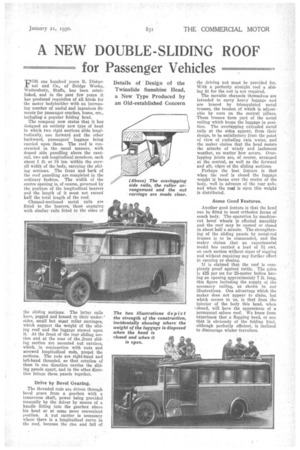A NEW DOUBLE-SLIDING ROOF for Passenger Vehicles
Page 53

If you've noticed an error in this article please click here to report it so we can fix it.
TOR one hundred years R. Distur_12 nal and Co., of Bridge Works, Wednesbuky, Staffs, has been established, and in the past few years it has produced requisites of all kinds for the motor bodybuilder with an increasing number of useful and ingenious fitments for passenger coaches, buses, etc., including a popular folding head.
The company now states that it has designed an entirely new type of head in which two rigid sections slide longitudinally, one forward and the other backward, passengers' luggage being carried upon them. The roof is constructed in the usual manner, with domed side panelling above the cantrail, two ash longitudinal members, each about 1 ft or 18 ins, within the overall width of the body, carrying the sliding sections. The front and back of the roof panelling are completed in the ordinary fashion. The width of the centre opening is, of course, governed by the position of the longitudinal bearers and the length of it must not exceed half the total length of the roof.
Channel-sectioned metal rails are fitted to the bearers, these engaging with similar rails fitted to the sides of
the sliding sections. The latter rails have, pegged and brazed to their under-4 sides, small but stout roller carriages, which support the weight of the sliding roof and the luggage stowed upon it. At the front of the rear sliding section and at the rear of the _front sliding section are mounted nut carriers, which, in conjunction with nuts and screwed longitudinal rods, propel the sections. The rods are right-hand and left-hand threaded, so that rotation of them in one direction carries the sliding panels apart, and in the other direction brings these panels together.
Drive by Bevel Gearing.
The threaded rods are driven through bevel gears from a gearbox with a transverse shaft, power being provided manually by the driver by means of a handle fitting into the gearbox above his head or at some more convenient position. A nut carrier is necessary where there is a longitudinal curve in the roof, because the rise and fall of
the driving nut must be provided for. With a perfectly straight roof a sliding fit for the nut is not required.
The movable channels themselves are intended to carry heavy luggage and are braced by triangulated metal trusses, the tension of which is adjustable by nuts on the central pillars. These trusses form part of the metal railing which keeps the luggage in position. The overlapping extruded metal rails at the sides appear, from their design, to be satisfactory from the point of view of excluding rain water, and the maker claims that the head resists the attacks of windy and inclement weather, no matter how severe. Overlapping joints are, of course, arranged at the central, as well as the forward and aft, edges of the sliding sections.
Perhaps the best feature is that when the roof is closed the luggage weight is borne over the centre of the body, well in advance of the rear axle, and when the roof is open this weight is distributed.
Some Good Features.
Another good feature is that the head can be fitted to most orthodox forms of coach body. The operation by machinecut bevel wheels is effected smoothly and the roof may be opened or closed in about half a minute. The strengthening of the sliding panels by metal-rod trusses is to be commended, and the maker claims that an experimental model has carried a load of 3 cwt. on each section without signs of sagging and without requiring any further effort in opening or closing.
It is claimed that the roof is completely proof against rattle. The price is f25 per set for 25-seater bodies having an opening approximately 7 ft. long, this figure including the supply of the necessary railing, as shown in our illustrations. One advantage which the maker does not appear to claim, but which occurs to us, is that from the interior of the body this head, when !closed, will have the appearance of a permanent saloon roof. We know from experienoe that a flapping head, or one that is obviously of the folding kind, although perfectly efficient, is inclined to discourage winter travellers.




















































































































